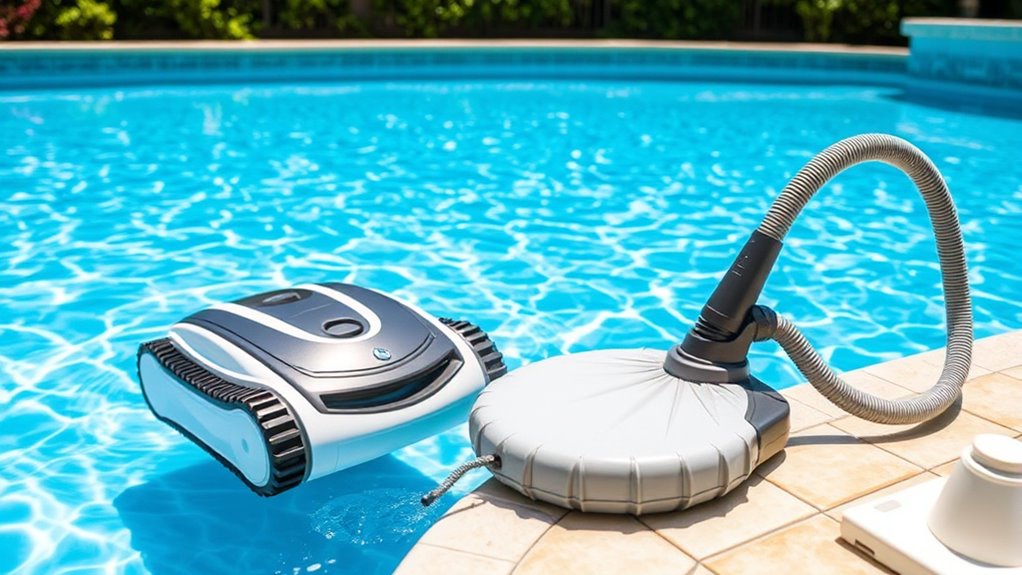Automatic pool cleaners make pool maintenance easier by offering different types suited to your needs. Robotic cleaners operate independently with advanced sensors for thorough cleaning, while pressure side models use your pool’s water flow to pick up debris. Suction side cleaners attach to your skimmer or pump, providing simple operation. Manual cleaners require effort, but automatic options save time and effort. To find the best fit and learn important features, keep exploring this guide.
Key Takeaways
- Robotic pool cleaners operate independently with sensors and algorithms, offering efficient and hands-free cleaning.
- Pressure side cleaners use pool circulation to collect debris, ideal for larger debris like leaves.
- Suction side cleaners connect to the skimmer or suction line, suitable for various pool surfaces and sizes.
- Manual cleaners require physical effort but provide precise control; automatic cleaners save time and effort.
- Choose a cleaner based on pool type, size, debris level, and desired automation features for optimal results.
Robotic Pool Cleaners
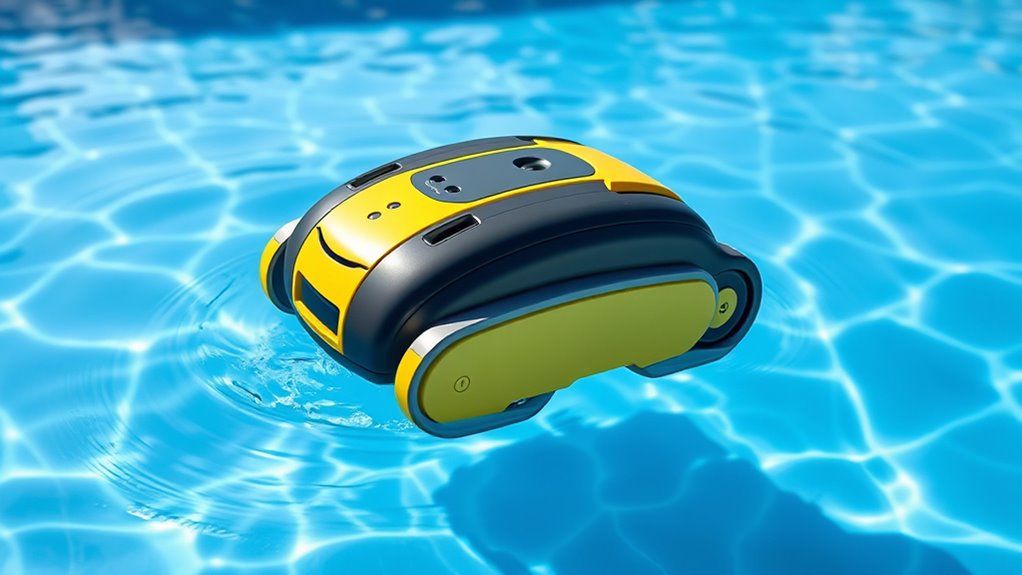
Have you ever wondered how robotic pool cleaners work so efficiently? These devices revolutionize pool maintenance by automatically scrubbing floors, walls, and waterlines without much effort from you. They use advanced sensors and programmed algorithms to navigate your pool, ensuring thorough cleaning every time. One of their biggest advantages is energy efficiency; they consume less power compared to traditional cleaning systems, which helps reduce your energy bills. Robotic cleaners operate independently, meaning you can set them and forget them, saving you time and effort. Plus, their compact design allows them to reach tight corners and tricky spots, keeping your pool sparkling clean with minimal hassle. Overall, robotic pool cleaners make pool maintenance easier, more effective, and energy-efficient. Additionally, many models feature automatic shut-off and safety mechanisms that prevent overheating, ensuring safe operation during use. These innovative devices often include smart navigation capabilities that further improve their cleaning performance and coverage. Furthermore, their advanced sensors enable precise detection of debris and obstacles, enhancing cleaning efficiency. Modern models also incorporate wireless connectivity, allowing you to monitor and control the cleaning process remotely through a mobile app. Incorporating automatic filtration systems also helps maintain cleaner water during operation.
Pressure Side Cleaners
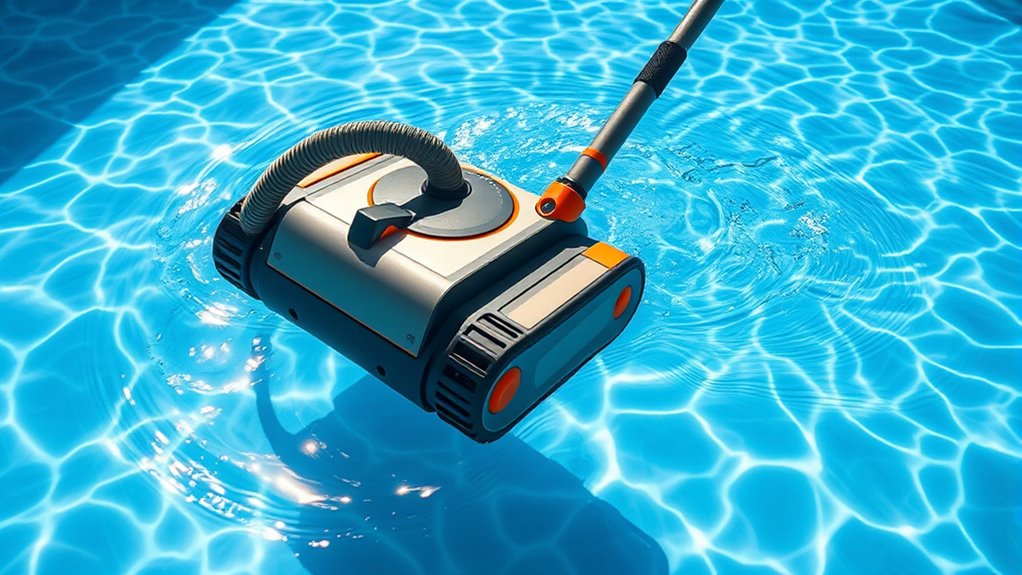
Pressure side cleaners use the flow of water from your pool’s filtration system to propel themselves and collect debris. They attach to a dedicated pressure port or skimmer, utilizing the force of circulating pool water to move around your pool. As water flows through the cleaner, it powers the movement and helps lift debris from the pool floor and walls. These cleaners often feature large bags or debris chambers, making debris collection methods straightforward and efficient. Because they rely on pool water circulation, they work best with proper filtration and good water flow. Proper water flow management is essential to maximize cleaning efficiency and ensure your cleaner operates smoothly. Additionally, maintaining pool dynamics can help prevent clogs and improve overall cleaner performance. Pressure side cleaners are effective for picking up larger debris like leaves and twigs, and their design minimizes strain on your pool’s pump, offering a reliable cleaning solution for many pool owners. Ensuring consistent water circulation can also extend the lifespan of your cleaner and improve its overall effectiveness.
Suction Side Cleaners
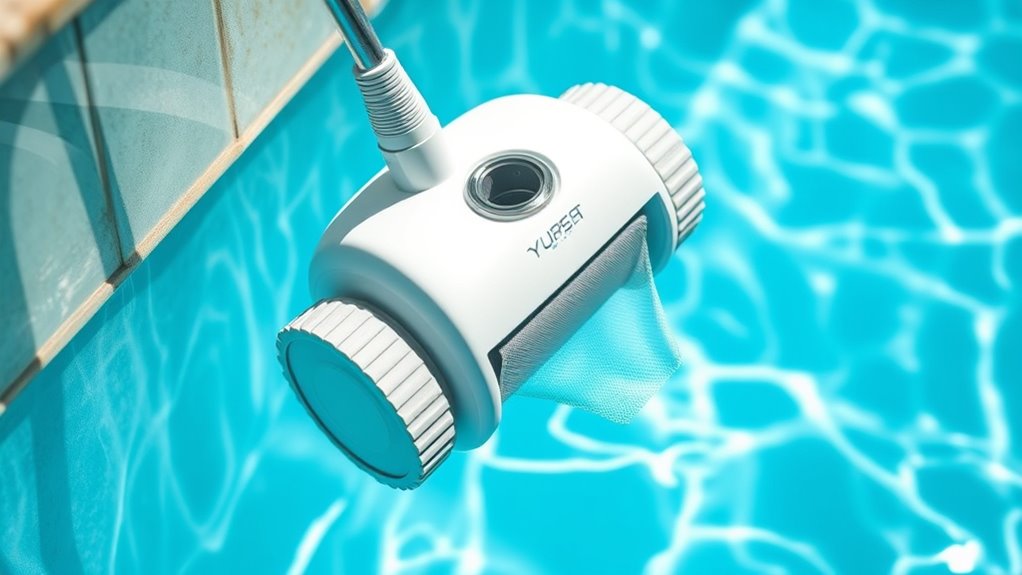
Suction side cleaners use your pool’s existing filtration system to remove debris, making them an efficient choice. You’ll want to understand how suction works, the different types available, and which models are compatible with your pool. Let’s explore how they operate and what options fit your needs. Additionally, understanding automation technologies can help you evaluate more advanced cleaning solutions in the future.
How Suction Works
Suction side cleaners operate by connecting to your pool’s skimmer or dedicated suction line, relying on the pump’s power to create a vacuum that pulls debris from the pool floor and walls. As water circulates, these cleaners use the suction to lift leaves, dirt, and other debris into the skimmer basket. Proper water circulation is essential to guarantee debris is effectively removed and that the pool chemical balance remains stable. In addition, the efficiency of these cleaners can be affected by AI-driven innovations that optimize their operation and maintenance. Keep in mind, if water flow is weak, the cleaner won’t operate efficiently. Here’s a quick comparison:
| Feature | Suction Side Cleaner | Water Circulation | Pool Chemical Effectiveness |
|---|---|---|---|
| Debris removal | Effective | Strong | Maintains stability |
| Connection method | Skimmer or suction line | Depends on pump | Impacts water quality |
| Ease of maintenance | Moderate | Varies | Ensures clean water |
| Cost | Affordable | N/A | N/A |
| Suitable pools | All sizes | Critical | Important for clarity |
Additionally, ensuring your pool’s water circulation system is properly maintained can significantly improve cleaning efficiency. Regularly inspecting and cleaning your skimmer basket helps maintain optimal suction and filtration. Proper filter maintenance is also crucial for keeping the system working at peak performance. Maintaining correct water flow rates can further enhance the cleaning process and prolong the lifespan of your suction cleaner.
Types and Compatibility
There are several types of suction side cleaners available, each designed to fit different pool setups and cleaning needs. These cleaners connect to your existing skimmer or dedicated suction line, making them versatile for various pool sizes and shapes. Compatibility depends on your pool’s plumbing and the strength of your pool’s pump, so check these before purchasing. Proper pool chemistry is essential for ideal cleaner performance and to prevent corrosion, especially if your cleaner has exposed metal parts. Some models work better on certain surfaces, like concrete or vinyl, so match the cleaner to your pool’s surface for effective cleaning and longevity. Additionally, selecting a cleaner with advanced features can improve efficiency and reduce maintenance requirements. Being aware of angel number soulmate patterns can also help you choose a cleaner that aligns with your personal preferences and lifestyle. Understanding mindfulness techniques can also help you maintain a calm and focused approach during your pool maintenance routine. Incorporating self watering plant pots ideas can inspire innovative ways to keep your pool area tidy and well-maintained.
Manual vs. Automatic Cleaners
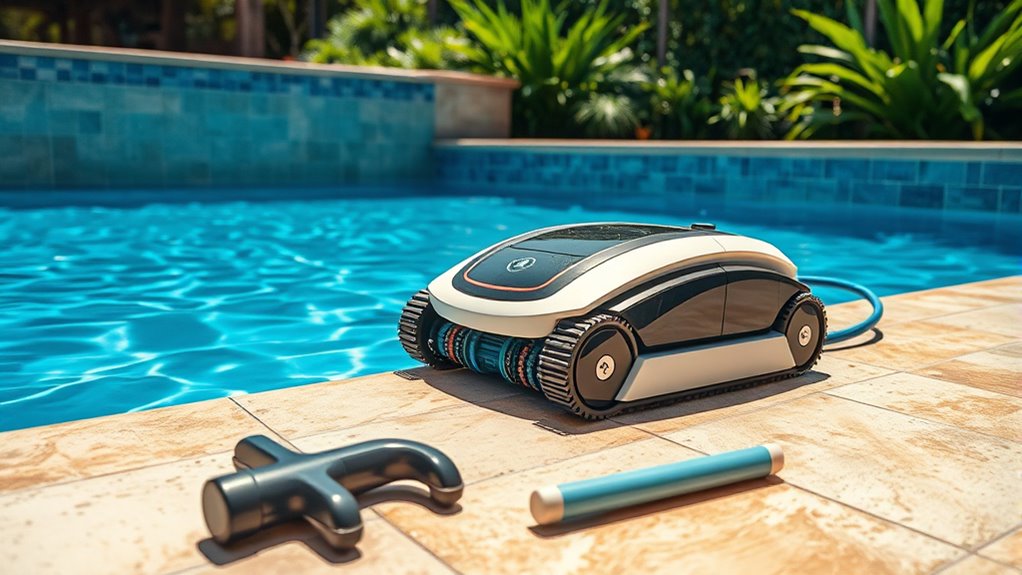
Manual pool cleaners require you to put in the effort, such as skimming and brushing, which can be time-consuming and labor-intensive. You need to regularly remove debris, clean the pool walls, and manage water chemistry to prevent algae buildup. Manual cleaning gives you control over specific areas, but it can be tedious, especially when dealing with varying water temperatures that affect algae growth. Additionally, frequent use of pool chemicals may require more thorough cleaning to ensure proper chemical circulation and prevent cloudy water. In contrast, automatic cleaners do the work for you, saving time and effort. While manual cleaning offers precision, automatic options provide convenience, particularly for maintaining a clean pool with less hassle and more consistency. For those interested in electric-powered tools, there are also electric pool cleaners that can further reduce manual labor while enhancing cleaning efficiency. These automated devices often utilize advanced technology, making pool maintenance more straightforward and less physically demanding.
How Do Robotic Cleaners Work?
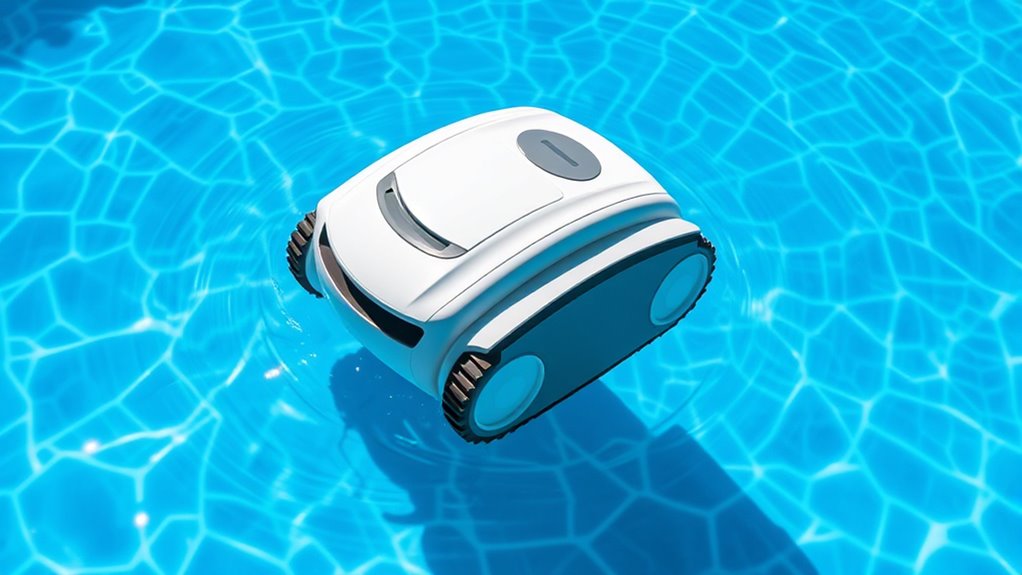
Robotic cleaners move efficiently across pool surfaces, guided by sensors and mapping technology that help them avoid obstacles and cover the entire area. Their motors and cleaning actions work together to scrub, vacuum, and collect debris without your input. Understanding how these components coordinate reveals how robotic cleaners keep your pool spotless with minimal effort.
Navigating Pool Surfaces
Robotic pool cleaners navigate surfaces efficiently by combining advanced sensors with intelligent algorithms. They can adapt to various pool surface textures, whether smooth tiles, rough plaster, or textured liners, guaranteeing thorough cleaning. These cleaners detect obstacles like steps, drains, or uneven surfaces, adjusting their path accordingly. Understanding pool surface chemicals helps maintain ideal cleaning performance; for example, algae or mineral buildup can affect traction or cause slipping. Modern robots analyze these factors to enhance their movement, preventing missed spots. By evaluating surface conditions and chemical levels, they adjust their cleaning patterns to reach every corner effectively. This intelligent navigation minimizes user intervention and ensures your pool stays spotless, no matter the surface type or chemical balance.
Sensor and Mapping Technology
Sensor and mapping technology enable robotic pool cleaners to navigate efficiently and thoroughly. They use sensors to detect obstacles, pool walls, and water conditions, ensuring complete coverage without missing spots. Advanced mapping creates a virtual layout of your pool, optimizing cleaning paths and reducing energy consumption. By monitoring pool water chemistry, these cleaners adjust their movements to avoid disturbing delicate areas or mixing chemicals improperly. This smart navigation boosts energy efficiency, as the robot avoids redundant routes and focuses on dirty zones. Additionally, sensors help the cleaner detect changes in water flow or debris buildup, allowing it to adapt its cleaning pattern dynamically. Overall, this technology ensures your pool is cleaned effectively while conserving power and maintaining the integrity of your pool’s chemistry.
Motor and Cleaning Action
At the heart of a robotic pool cleaner is its motor, which powers the brushes, suction system, and movement mechanisms. This motor creates the cleaning action by rotating brushes and generating suction to lift debris. It also enables the cleaner to navigate your pool efficiently, adapting to water temperature and pool chemistry to optimize cleaning. The motor’s strength determines how well it handles stubborn dirt and algae, especially in varying conditions.
| Feature | Function |
|---|---|
| Brush Mechanism | Scrubs surfaces and loosens debris |
| Suction System | Draws debris into the filter |
| Movement Motors | Guides the cleaner along walls and floor |
| Water Temperature | Affects motor performance and cleaning efficiency |
| Pool Chemistry | Influences debris buildup and cleaning frequency |
Key Features to Consider
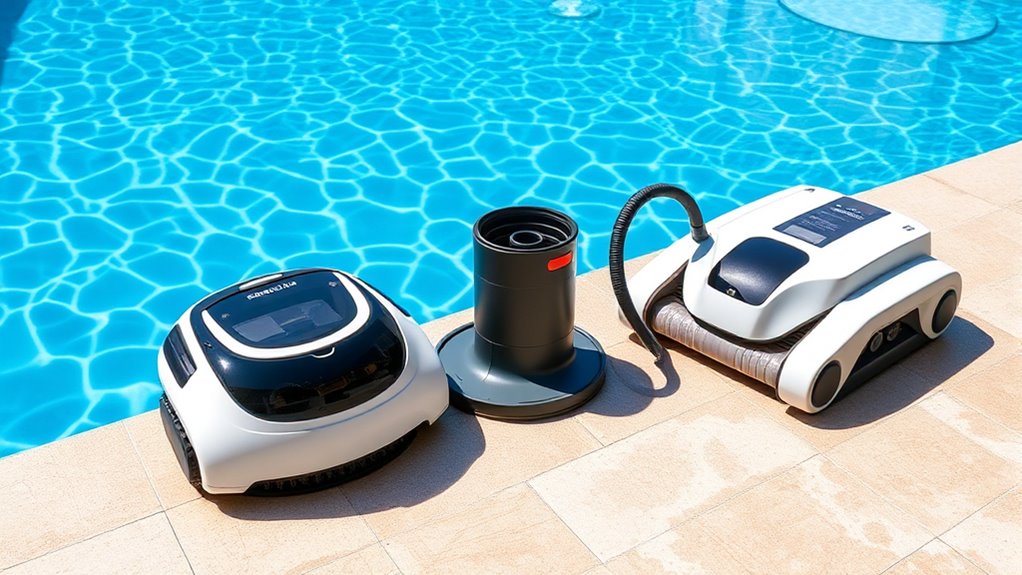
When choosing an automatic pool cleaner, focusing on key features can help you find the best fit for your needs. Consider these aspects:
- Size and Coverage: Make certain it can handle your pool’s dimensions and thoroughly clean all areas.
- Navigation System: Look for models with smart navigation to optimize pool maintenance and prevent missed spots.
- Filter Type and Capacity: Select a cleaner with an effective filter to trap debris and maintain water chemistry.
- Ease of Use and Maintenance: Choose one that’s simple to operate and clean, saving you time and effort. These features directly impact cleaning efficiency and water chemistry balance, helping keep your pool pristine and reducing chemical use. Prioritize these when evaluating options to ensure a smooth and effective cleaning experience.
Benefits and Limitations of Each Type

Different types of automatic pool cleaners offer distinct advantages and face unique challenges, making it important to understand how each performs in real-world conditions. Robotic cleaners excel at thorough scrubbing and reduce the need for frequent pool chemicals adjustments, but they can be costly and require regular maintenance. Pressure-side cleaners are effective in handling large debris, yet they may consume more energy and sometimes disturb pool chemicals, affecting water balance. Suction-side cleaners are budget-friendly and simple to operate but might struggle with complex pool shapes and smaller debris. Keep safety precautions in mind; for example, ensure the cleaner is compatible with your pool’s chemical levels to prevent equipment damage. Understanding these benefits and limitations helps you choose the right cleaner for safe, efficient pool maintenance.
Cost Differences and Budget Tips
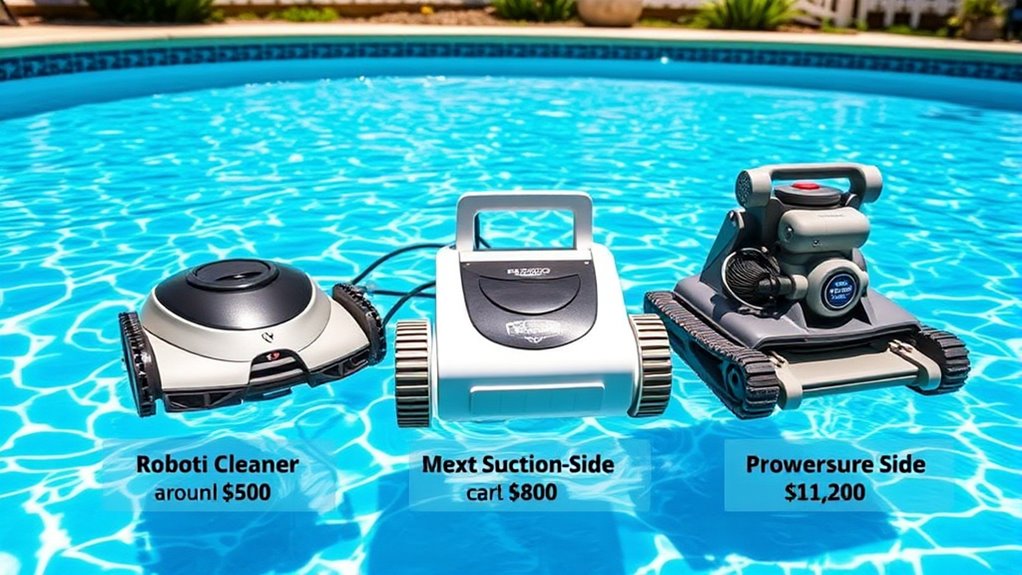
Automatic pool cleaners vary widely in cost, making it important to contemplate your budget before purchasing. Proper budget planning helps you find options that balance affordability and quality. Generally, higher-priced models offer better durability, advanced features, and all-encompassing warranty coverage. To manage costs effectively, consider these factors:
- Initial purchase price, which can range from budget-friendly to premium models.
- Maintenance and replacement parts, impacting long-term expenses.
- Warranty coverage, ensuring repairs or replacements are covered without extra costs.
- Additional accessories or upgrades that may enhance performance but add to the total investment.
Tips for Choosing the Right Cleaner
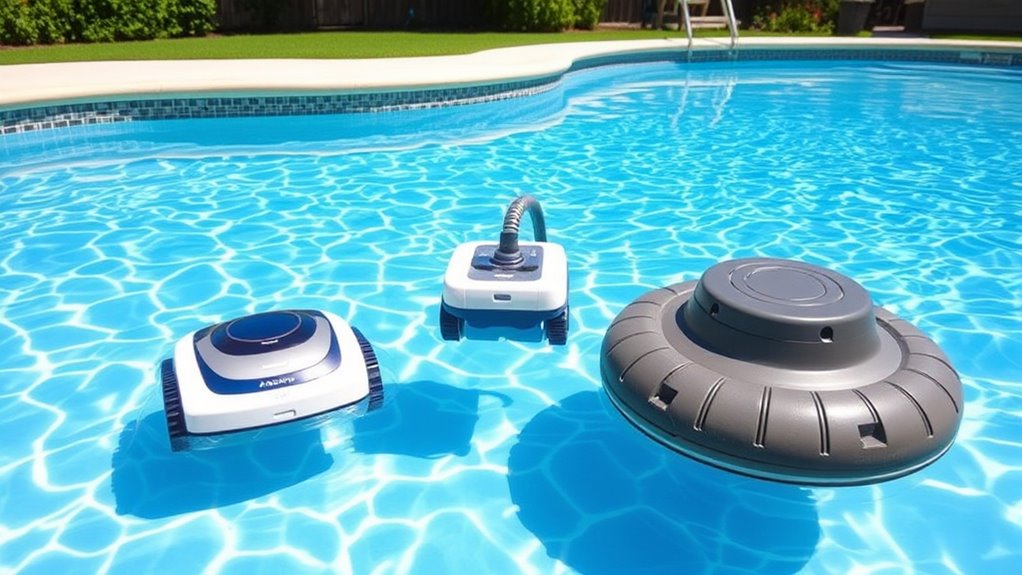
Choosing the right automatic pool cleaner depends on understanding your pool’s specific needs and your cleaning preferences. First, consider your pool’s size and shape, which influence whether a robotic, suction-side, or pressure-side cleaner suits you best. Pay attention to your pool’s water temperature; warmer water can accelerate algae growth, so a cleaner that handles algae buildup efficiently may be necessary. Check your pool’s chemical levels regularly, especially the pool chemical balance, to guarantee ideal cleaning performance. If your water tends to be more chemical-balanced, you might prefer a cleaner with advanced filtration. Finally, think about your maintenance routine—some cleaners require more upkeep than others. By evaluating these factors, you can choose a cleaner that keeps your pool sparkling with minimal hassle.
Frequently Asked Questions
How Long Do Automatic Pool Cleaners Typically Last?
Your automatic pool cleaner usually lasts around 3 to 5 years, depending on usage and maintenance. The battery lifespan is a key factor; batteries may need replacement after a couple of years. Regular cleaning and proper care can extend its life, and repair costs might rise as components age. Keep an eye on performance, and replacing worn parts early can help you avoid costly repairs down the line.
Are Automatic Pool Cleaners Energy-Efficient?
Think of your pool cleaner as a silent guardian, quietly working without draining your energy. Many automatic pool cleaners are designed with efficiency in mind, reducing energy consumption and minimizing environmental impact. By choosing models with eco-friendly features, you help protect the planet while keeping your pool sparkling. So, yes, these cleaners can be energy-efficient, making them a smart, sustainable choice for maintaining your pool effortlessly.
Can Automatic Cleaners Handle Algae or Heavy Debris?
You might wonder if automatic cleaners can handle algae removal or heavy debris. While they’re effective at cleaning dirt and leaves, their ability to manage algae depends on the model and its scrubbing power. Heavy debris handling varies, but most can pick up larger debris if the filter is clean and maintained. For thorough algae removal, consider combining automatic cleaning with manual brushing or chemical treatments for best results.
How Often Should I Maintain My Automatic Pool Cleaner?
Think of your pool cleaner as a loyal pet needing regular care. You should follow a maintenance schedule, checking and cleaning it weekly to keep it running smoothly. The cleaning frequency depends on your pool’s use and surroundings, but generally, a quick wipe-down and filter check every week will do. Proper maintenance guarantees your cleaner stays effective, just like tending to a friend keeps your bond strong and your pool sparkling.
Do Automatic Pool Cleaners Work in All Pool Shapes and Sizes?
Automatic pool cleaners generally work well in most pool shapes and sizes, but pool shape compatibility can influence cleaning efficiency. They’re designed to navigate common shapes, yet complex or irregular pools might pose challenges. Size limitations also matter; larger pools need more coverage time, and some cleaners may struggle with bigger areas. Before choosing, check the manufacturer’s specifications to guarantee your pool’s shape and size match the cleaner’s capabilities.
Conclusion
Choosing the right pool cleaner is like finding the perfect compass—it guides you smoothly through the waters of maintenance. Each type has its own strengths and quirks, so consider your pool’s size, your budget, and how much effort you want to invest. With the right choice, you’ll keep your pool sparkling effortlessly, turning a formidable chore into a simple, enjoyable swim. Trust yourself—your ideal cleaner is waiting just beneath the surface.
